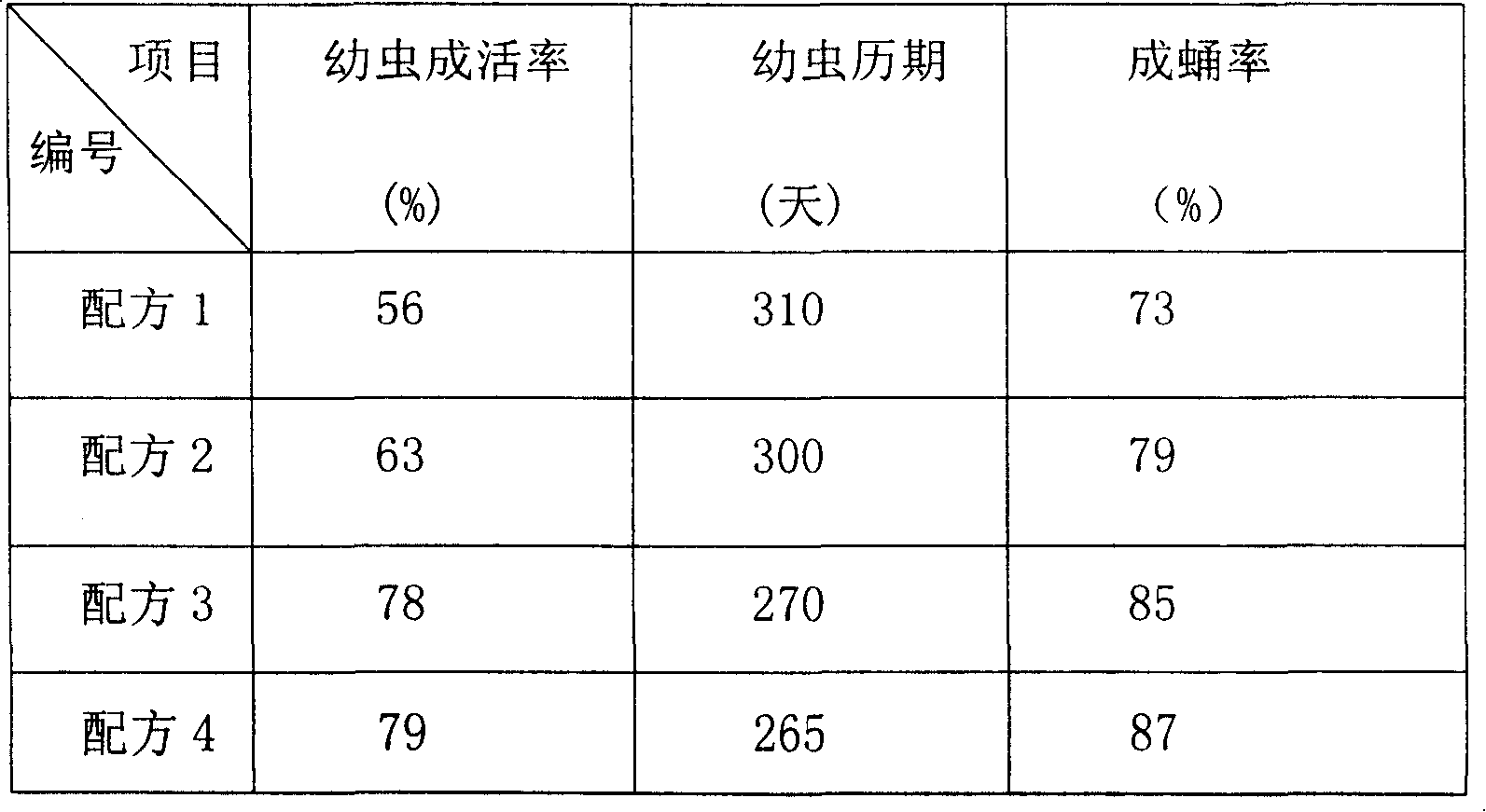Artificial feeding and culture transfer of monochamus alternatus hope and artificial feed for larva thereof
A technology of monochamus and artificial feed, which is applied to animal feed, animal feed, hunting equipment, etc., can solve the problems of unguaranteed supply quantity and time, and achieve high larval survival rate, short duration, guaranteed output and quality effect
- Summary
- Abstract
- Description
- Claims
- Application Information
AI Technical Summary
Problems solved by technology
Method used
Image
Examples
Embodiment 1
[0045] Select 200 chrysalis chrysalis pupae, and under the condition of 25 ℃, 189 adult chrysalis eclosions will be put into the cages equipped with pine needles according to the ratio of male to female ratio of 1:1. Each cage contains 50 adult chrysalis. First, lay eggs after 15 days, 4500 eggs are laid, the egg period is 10 days, the eggs are routinely sterilized (soaked in 10% formalin solution for 1 hour, then rinsed with clean water, and dried in the shade), at 25°C Next, 4050 hatching larvae were hatched, and the artificial feed was heated and mixed according to formula 1 in Table 1, and then packed into the feeding containers of Alchachamus larvae, and the newly hatched larvae were inserted (1 newly hatched larva was inserted into each container) After 30 days, 2,268 larvae survived, and 1,656 larvae became pupae after 310 days. The pupae continued to be placed on the feed surface, and 1,474 adults emerged after 17 days.
Embodiment 2
[0047] 180 chrysalis chrysalis pupae were selected, and 165 adult chrysalis erupted under the condition of 25°C, and the adult chrysalis monochamus were put into cages equipped with pine needles according to the ratio of male to female ratio of 1:1, and 50 adult worms were packed in each cage. First, lay eggs after 14 days, 4400 eggs are laid, the egg period is 8 days, the eggs are routinely sterilized (soaked in 10% formalin solution for 1 hour, then rinsed with clean water, and dried in the shade), at 25°C Next, 4004 hatched larvae were hatched, and the artificial feed was heated and mixed according to formula 2 in Table 1, and then packed into the larvae raising containers of Monochamus alternatus, and the newly hatched larvae were inserted (one newly hatched larva was inserted into each container) After 30 days, 2522 larvae survived, and 1992 pupae emerged after 300 days. The pupae continued to be placed on the surface of the feed, and 1793 adults emerged after 15 days.
Embodiment 3
[0049] 300 chrysalis chrysalis pupae were selected, and 278 adult chrysalis erupted under the condition of 25°C, and the adult chrysalis monochamus were put into cages equipped with pine needles according to the ratio of male to female ratio of 1:1, and 50 adult worms were packed in each cage. First, lay eggs after 12 days, 6880 eggs are laid, the egg period is 7 days, the eggs are routinely sterilized (soaked in 10% formalin solution for 1 hour, then rinsed with clean water, and dried in the shade), at 25°C Next, 6260 hatching larvae were hatched, and the artificial feed was heated and mixed according to formula 3 in Table 1, and distributed into the feeding containers of Monochamus alternatus larvae, and the newly hatched larvae were inserted (one newly hatched larva was inserted into each container) After 30 days, 4,883 larvae survived, and 4,151 larvae became pupae in 270 days. The pupae continued to be placed on the surface of the feed, and 3,736 adults emerged after 12 da...
PUM
 Login to View More
Login to View More Abstract
Description
Claims
Application Information
 Login to View More
Login to View More - R&D
- Intellectual Property
- Life Sciences
- Materials
- Tech Scout
- Unparalleled Data Quality
- Higher Quality Content
- 60% Fewer Hallucinations
Browse by: Latest US Patents, China's latest patents, Technical Efficacy Thesaurus, Application Domain, Technology Topic, Popular Technical Reports.
© 2025 PatSnap. All rights reserved.Legal|Privacy policy|Modern Slavery Act Transparency Statement|Sitemap|About US| Contact US: help@patsnap.com

